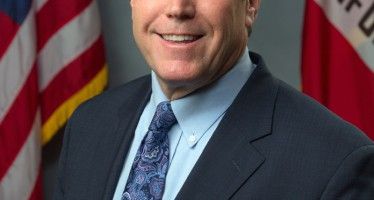TX anti-drought plan is SWIFT; CA’s is SLOW

In Texas they call their emergency drought alleviation plan SWIFT, short for State Water Improvement Fund for Texas.
 In California, they might as well call our bundle of water projects SLOW, for the “State that Left Out Water” from its water plans.
In California, they might as well call our bundle of water projects SLOW, for the “State that Left Out Water” from its water plans.
The contrast between the two states indicates how California, even with a supermajority one-party government, cannot move quickly to build new dams to alleviate droughts or court-ordered shutdowns to protect fish during dry years. Thus, the unofficial water plan for California is to take water from farmers as the only alternative.
The Texas SWIFT project already is funded by $2 billion in cash out of the state’s “rainy day fund” and a voter-approved $6 billion water bond.
Texas also has a $53 billion water bond on the ballot for November 2013, including 26 new reservoirs, to undertake long-range plans to alleviate future droughts and accommodate an expected 10 million new residents by 2050. Texas welcomes growth and is planning for it.
CA SLOW
In California, the state also has a $53 billion bundle of water plans for conveyance tunnels, Delta Restoration, Delta levee repairs, and a water bond that would build up to 3 new reservoirs.
California’s $11 billion water bond was withdrawn from the ballot in 2010 and again in 2012, and is pending review by the voters in November 2014. It is called the Safe, Clean and Reliable Drinking Water Act.
California’s water bond would only fund two to three new reservoirs. That is, if environmentalists don’t block the reservoirs’ construction or require such costly mitigations that the projects would have to be abandoned. Thus the default water plan in California calls for taking water back from farmers, rather than building new dams or making Delta water deliveries more reliable.
Unlike Texas, California has had no budget reserves or drought fund to move quickly to alleviate drought conditions.
Gov. Jerry Brown and the state Legislature can move forward building water conveyance tunnels through the Delta without voter approval. But there is push back due to the cost of the tunnels and the destruction of local farming lands. And the environmental impact report for state’s Delta Restoration Plan is already tied up in lawsuits.
Texas uses 100 gallons less per household per day than CA
California has a self-created image of the leading state when it comes to water and energy conservation. But Texas households use 100 gallons a day less per household on average than California households (see table below). California can’t even keep up with Texas’ water conservation performance despite Texas’ much hotter climate.
On average, Texas uses 9.2 million acre-feet of water per year for agricultural irrigation. California uses 34 million acre-feet. An acre-foot of water is a football field of water one foot high. Roughly, about 3 acre feet of water are needed to irrigate one acre of farmland per year. If water use is an accurate gauge, California’s agricultural economy is three times that of Texas.
California’s agricultural economy would shrink if it were not for farmers shifting to groundwater supplies during natural droughts or bureaucratic reductions in water deliveries. California groundwater adjudication is more than a century old and actually works quite well deciding water rights among private parties, as well as for governments at all levels. But environmentalists want to eliminate all water rights law by having government regulate all withdrawals of groundwater.
Unfortunately, the default water policy of California is one of subtraction: take water from farmers by environmental lawsuits to protect fish that don’t need protection; and by Congressional takebacks of previous federal water allocations.
Californians may be getting tired of comparisons with Texas. But water allocation and conservation is another area in which the Lone Star State is looking toward providing for its SWIFT, inevitable future of growth in population and business. The Golden State is squandering its existing riches while being SLOW to provide for future needs.
California versus Texas Water Systems and Anti-Drought Plans
| Texas | California | |
| Enacting Legislation | HB4 & HB1025 | Safe, Clean & Reliable Drinking Water Supply Act — SBx7-2AB 1265, AB153, |
| Up for statewide election | Nov. 5, 2013 | Nov. 4, 2014 |
| Early Funding Appropriation | $2 billion (cash) from “rainy day” fund | $0 |
| Total Proposed Funding | $53 billion | $53 billionWater bond: $11.1 billionTunnels: $14 billionRestoration: $10 billionLevee Repairs: $4 billion
Interest: $14 billion |
| No. of New Reservoirs | 26 | 2 to 3 |
| Voter Approval | Proposition 2: $6 billion in bondsVoter approval 2011 | Proposition 18 (2010)(postponed) |
Water Usage (2009)
|
Municipal: 4.2 million acre feetIndustrial: 1.7 million acre feetSubtotal: 5.9 million acre feetIrrigation: 9.2 million acre feetOther: 919 thousand acre feet
Total: 18.2 million acre feet |
Municipal: 9.0 million acre feetIndustrial: 0.7 million acre feetSubtotal: 9.7 million acre feetIrrigation: 34 million acre feetOther: N/A
Total: 43 million acre feet |
| Yearly use per person for municipal & industrial | 0.23 acre foot per person | 0.26 acre foot per person |
| Total Population | 25,145,561 | 37,253,956 |
| Pop. Growth Rate 2010 to 2012 | 3.5% | 2.1% |
| Total Households 2010 | 8,667,807 | 12,433,172 |
| Average Household Size | 2.9 persons | 3.0 persons |
| Average Gallons Water Consumed per HouseholdPer Day | 595 gallons per day | 696 gallons per day |
Related Articles
Gov. Brown vows climate firewall against President-elect Trump
With just a few years left in his marathon return tour as California governor, Jerry Brown has promised not to back
Bill would allow AWOL state employees to keep jobs
SACRAMENTO — Imagine you miss work for five consecutive days and don’t call your supervisor to explain why. You probably
GOP lawmaker: fund schools with high-speed rail bonds
A Republican lawmaker wants to turn money for California’s high-speed rail project into funding for schools. Assemblyman Scott Wilk, R-Santa




